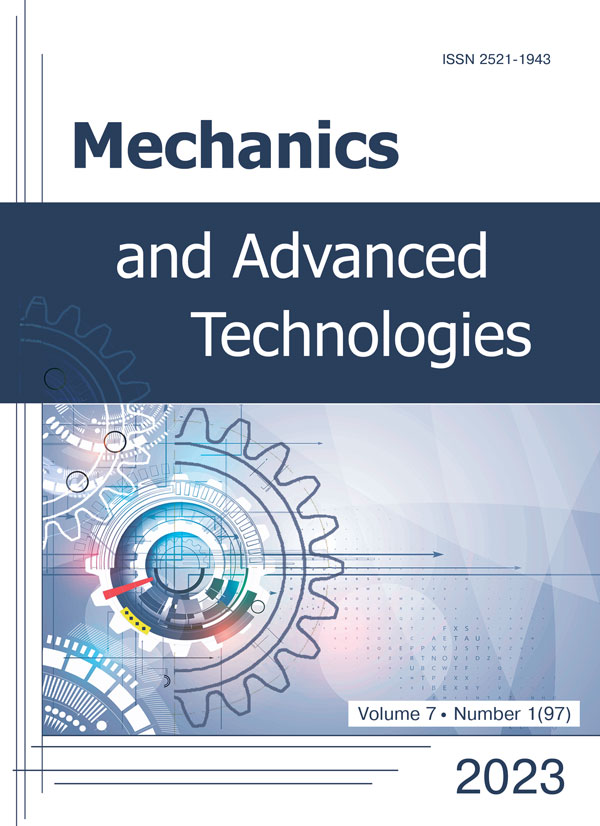Automation of the procedure for determining the admissibility of erosion- corrosion wear in pipelines of nuclear power plants made of carbon steels
DOI:
https://doi.org/10.20535/2521-1943.2023.7.1.272443Keywords:
nuclear power plant, pipeline, erosion-corrosion wear, wall thinning defect, viscous fracture, stress of the limit plastic state, software, finite element methodAbstract
Many pipelines in Ukrainian nuclear power plants have been in operation for over 30 years, and the determination of the admissibility of erosion-corrosion wear (ECW) defects in the pipeline wall metal is currently one of the pressing issues in the nuclear energy sector of Ukraine. A comparative analysis of determining the admissibility of pipe wall thinning due to ECW was conducted using the adopted methodology “MT-T.0.03.224-18” by the State Enterprise “Energoatom” and the guidance based on the use of regulatory documents for designing pipeline elements. The use of the methodology demonstrated significant advantages in terms of reducing the conservatism of ECW assessment, especially for small-scale thinning and pipelines operating at pressures below 60-80 kgf/cm2, which allows for a substantial reduction in repair work. However, the implementation of the methodology in practice may encounter difficulties due to the complexity and labor-intensiveness of the calculation assessment procedure for nuclear power plant personnel. Therefore, to automate the ECW admissibility assessment in accordance with the methodology requirements, software (SW) was developed for use by nuclear power plant personnel, enabling the prompt generation of a protocol for the express assessment procedure of ECW admissibility for a straight section of the pipeline based on the measurement results of wall thinning parameters in the axial direction. The software allows for concluding whether the section can be put into operation, sent for repair, or requires further refined assessment. Additionally, software based on the finite element method (FEM) was developed, which, when necessary, allows for a refined assessment of a straight section, taking into account the depth and angle of thinning in the circumferential direction, and calculates the stress of the limit plastic state of the pipeline section with ECW from the perspective of viscous fracture. The devel- opment is applicable in the field of nuclear energy in Ukraine.
References
- S. Ageiev, “Methodology for assessing the permissible thicknesses of NPP pipeline elements made of carbon steel under conditions of erosion-corrosion wear”, Nuclear and Radiation Safety, no. 3(91), pp. 32–42, 2021. DOI: https://doi.org/10.32918/nrs.2021.3(91).04.
- І. Biblik, К. Avramov and R. Rusanov, “Prediction of flow accelerated corrosion of NPP pipeline elements by network simulation method”, J. of Mech. Eng., vol. 21, no. 3, pp. 13–19, 2018. DOI: https://doi.org/10.15407/pmach2018.03.013.
- IN-T.0.03.190-14. Unified instructions for measuring wall thickness of pipeline elements subject to erosion-corrosion wear using ultrasound.
- OST 24.125.33-89. Otvody gnutyye dlya truboprovodov AES. Konstruktsiya i razmery.
- OST 24.125.04-89. Otvody gnutyye dlya truboprovodov AES. Konstruktsiya i razmery.
- Normy rascheta prochnosti oborudovaniya i truboprovodov AES (PNAE G-7-002-86). Moskva: Energoatomizdat, 1989, 525 p.
- MT-T.0.03.224-18. Methodology of definition allowable thicknesses of the elements of pipelines in NPP from carbonaceous steels subjected to effect of erosion-corrosion wear, 2019.
- I. Orynyak, S. Ageiev and S. Radchenko, “Local and global reference stresses for circumferential irregular-shaped defects in pipes”, J. Pressure Vessel Technology, vol. 137, no. 4, p. 041203, 2015. DOI: https://doi.org/10.1115/1.4028680.
- RD EO 1.1.2.11.0571-2015. Normy dopuskayemykh tolshchin stenok elementov truboprovodov iz uglerodistykh staley pri erozionno-korrozionnom iznose (vzamen RD EO 1.1.2.11.0571-2010, RD EO 0571-2006).
- E. Gipon and S. Trevin, "Flow-accelerated corrosion in nuclear power plants", in Nuclear Corrosion, vol. 69, Woodhead Publishing, 2020, pp. 213-250. DOI: https://doi.org/10.1016/B978-0-12-823719-9.00006-8.
- B. Poulson, "Predicting and Preventing Flow Accelerated Corrosion in Nuclear Power Plant", International Journal of Nuclear Energy, vol. 2014, p. 423295, 2014. DOI: https://doi.org/10.1155/2014/423295.
Downloads
Published
How to Cite
Issue
Section
License
Copyright (c) 2023 Григорій Ворона, Олег Махненко, Микита Ананченко

This work is licensed under a Creative Commons Attribution 4.0 International License.
Authors who publish with this journal agree to the following terms:
- Authors retain copyright and grant the journal right of first publication with the work simultaneously licensed under CC BY 4.0 that allows others to share the work with an acknowledgement of the work's authorship and initial publication in this journal.
- Authors are able to enter into separate, additional contractual arrangements for the non-exclusive distribution of the journal's published version of the work (e.g., post it to an institutional repository or publish it in a book), with an acknowledgement of its initial publication in this journal.
- Authors are permitted and encouraged to post their work online (e.g., in institutional repositories or on their website) prior to and during the submission process, as it can lead to productive exchanges, as well as earlier and greater citation of published work











